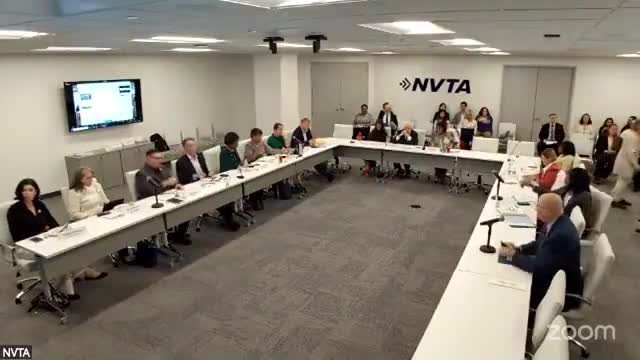Virginia Passenger Rail Authority briefs NVTA on Long Bridge work, 2030 completion target
October 10, 2025 | Northern Virginia Transportation Authority, Boards and Commissions, Executive, Virginia
This article was created by AI summarizing key points discussed. AI makes mistakes, so for full details and context, please refer to the video of the full meeting. Please report any errors so we can fix them. Report an error »

Virginia Passenger Rail Authority Executive Director D.J. Statler told the Northern Virginia Transportation Authority Oct. 9 that VPRA’s work to add passenger rail capacity through the Long Bridge and related projects is underway and that phase‑level funding is in place for the initial packages.
Statler said Long Bridge — the Potomac River rail crossing between Alexandria and Washington, D.C. — is a primary constraint on capacity: “During peak periods, it's at 90% capacity,” he said, and that adding dedicated passenger tracks and other projects is the primary way to deliver more frequent, reliable service. The authority heard technical details about construction sequencing, service impacts and alternate short‑term services during multi‑year construction.
Key points from the briefing:
- VPRA’s mission is to add passenger capacity between Washington and Richmond, and it has authority to acquire rail assets to separate passenger and freight operations.
- Long Bridge work is split into north and south packages. VPRA staff described major construction challenges where the new bridge intersects existing rail, Metro and highway infrastructure in the Washington Channel area.
- To complete some in‑place work where tracks must be taken out of service, VPRA is negotiating a limited five‑hour daily construction window during which trains will not pass through a constrained segment. Statler described a plan that shifts some trains to/from Alexandria for the construction windows so passenger services can continue while crews perform critical work.
- VPRA described a suite of temporary mitigation measures during construction, including express buses that will use hot lanes as an alternate during the multi‑year work; the agency expects those buses to begin in January 2026 and to operate through the principal construction period (roughly four years).
- VPRA plans to expand state‑supported service over the coming years and restore/expand VRE frequencies once core construction is complete in the 2030 timeframe.
Statler also reviewed community outreach and communications work, including station pop‑ups, disruption maps and public materials. He said much of the early work is on schedule and that the first two phases culminating in Long Bridge are fully funded. Statler traced VPRA’s statutory origin to the General Assembly and said the authority is intended to provide continuity across gubernatorial transitions.
Questions from the authority focused on the construction window, potential night or weekend work in the District of Columbia, and the duration of temporary bus service; Statler said the District has stringent noise/vibration rules and any night work would require a short waiver process for increments of time rather than a single long permit.
No formal vote was taken; the item was a staff briefing.
Statler said Long Bridge — the Potomac River rail crossing between Alexandria and Washington, D.C. — is a primary constraint on capacity: “During peak periods, it's at 90% capacity,” he said, and that adding dedicated passenger tracks and other projects is the primary way to deliver more frequent, reliable service. The authority heard technical details about construction sequencing, service impacts and alternate short‑term services during multi‑year construction.
Key points from the briefing:
- VPRA’s mission is to add passenger capacity between Washington and Richmond, and it has authority to acquire rail assets to separate passenger and freight operations.
- Long Bridge work is split into north and south packages. VPRA staff described major construction challenges where the new bridge intersects existing rail, Metro and highway infrastructure in the Washington Channel area.
- To complete some in‑place work where tracks must be taken out of service, VPRA is negotiating a limited five‑hour daily construction window during which trains will not pass through a constrained segment. Statler described a plan that shifts some trains to/from Alexandria for the construction windows so passenger services can continue while crews perform critical work.
- VPRA described a suite of temporary mitigation measures during construction, including express buses that will use hot lanes as an alternate during the multi‑year work; the agency expects those buses to begin in January 2026 and to operate through the principal construction period (roughly four years).
- VPRA plans to expand state‑supported service over the coming years and restore/expand VRE frequencies once core construction is complete in the 2030 timeframe.
Statler also reviewed community outreach and communications work, including station pop‑ups, disruption maps and public materials. He said much of the early work is on schedule and that the first two phases culminating in Long Bridge are fully funded. Statler traced VPRA’s statutory origin to the General Assembly and said the authority is intended to provide continuity across gubernatorial transitions.
Questions from the authority focused on the construction window, potential night or weekend work in the District of Columbia, and the duration of temporary bus service; Statler said the District has stringent noise/vibration rules and any night work would require a short waiver process for increments of time rather than a single long permit.
No formal vote was taken; the item was a staff briefing.
View full meeting
This article is based on a recent meeting—watch the full video and explore the complete transcript for deeper insights into the discussion.
View full meeting
